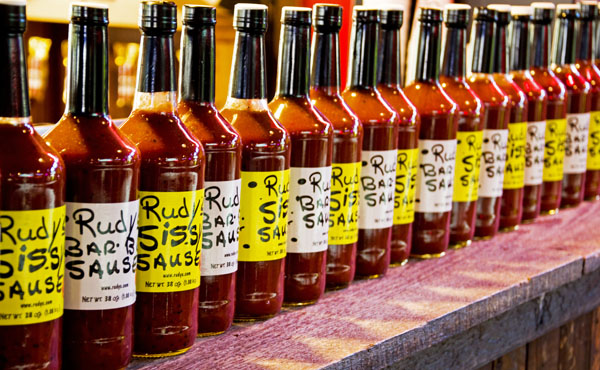Ever since the dawn of the spice trade, the work of traveling merchants has helped homogenize world cuisine. Migrants, too, bring along traditional recipes and infuse their new homes with tastes from the old country. The effect is a wonderful variety of constantly improving food, but at the expense of regional and national distinctiveness. In America, where people move freely and trade aggressively, the forces of homogenization are stronger then we often realize.
When we set out on our Great American Road Trip, we expected to be wowed by “authentic” regional cuisine. We thought, for example, we’d find the best chicken and dumplings in the Deep South, and the best Mexican cuisine along the Mexican border and throughout the South West. When we rolled into Texas, we felt like we entered the home turf of America’s all-star barbeque team, and had expectations to match.
What we discovered, instead, is that great flavors, regional recipes, and techniques know no boundaries. Texas’ signature slow-cooked, smoky, dry-rubbed, meat is pretty much standard barbeque procedure everywhere in the country now. You don’t have to travel to the Salt Lick in Driftwood, TX, to get Texas style barbeque. Not everyone does it as well as the Salt Lick, to be sure, but more and more places do it just as good.
It’s even possible that strict adherence to time-honored traditions is holding back regional cuisine. Other places, not bound by a historic sense of “authentic” styles, are freer to borrow best practices and invent new ones, often with amazing results.
Texas barbeque, for example, is traditionally a celebration of meat with less emphasis on the sauce. But when other regions of the country adopt your basic que’ing techniques, one of the main things left to distinguish yourself is great sauce. It’s no surprise, then, that our favorite barbeque anywhere in the country is a place called SandFly BBQ, which, in addition to deliciously slow-cooked meat offers three solid sauces: a traditional sweet and peppery red sauce, a spicy red, and an absolutely killer mustard-vinegar sauce. What is surprising about SandFly is that this best of the U.S. barbeque (according to us) isn’t located in any of the traditionally great barbeque Meccas. It’s not in Texas or Memphis or Kansas City or the Carolinas. It’s in Savannah, Georgia.
The best Mexican we’ve had on the road? Papas and Beer in Hendersonville, North Carolina. There is no rhyme or reason to it. There doesn’t need to be.
Before we started traveling fulltime I believed that traditional food meant better food. But now I think fusion is king. The best Chinese food need not be authentic, and authentic Chinese may not be the best. In one sense this complicates our lives because we can’t simply travel to a destination and expect the food to live up to its reputation. We know it hasn’t always for us. But this also suggests that amazing food is served up just about everywhere, including in our own back yards. Our job is to find it. Kind of like a culinary treasure hunt. How exciting is that?






















I think the problem with your perception that regional cuisine is irrelevant is that your thesis is based on research gained from restaurants. Perhaps you need to look into more “backyards” to discover its relevance. I am a chef who travels the world exploring regional cuisine. I wonder if the chef at the Mexican restaurant was a native of Hendersonville? I wouldn’t tell anyone in Savannah their city’s not a BBQ mecca. Besides, Carolina BBQ is a lot different than Texas BBQ. Homogenization of American cuisine simply dulls collective taste buds making the relevance of regional foods all the more important.
LikeLike
Unfortunately, on most of our travels, we don’t normally have strangers invite us into their kitchens and backyards to sample their cooking. Restaurants, on the other hand, tend to have an open door policy. 😉
But the idea that the chef at the Mexican restaurant may not be native to Hendersonville is exactly the point, don’t you think? Great Mexican chefs don’t need to stay in Mexico or close to the boarder. They can, and do, relocate. When they do, they take their fabulous kitchens with them. Sometimes they even pick up new techniques and flavors from the locals and improve upon their traditional dishes.
That’s been our experience, anyway. Often the best “regional” food we taste is served up very far from its place of origin.
LikeLike
But the great Mexican chef learned his regional technique from his region – his grandmother’s knee so to speak – not in Hendersonville. Sure, I’m a chef, I know I can teach myself any regional cuisine and pass it off, but that doesn’t mean I’m going to fool a “native.” According to my 87 year old mother-in-law/Katrina refugee living by us in Philadelphia & my New Orleans wife, cajun/New Orleans cuisine is non-existant in both Philadelphia and New York. I would not be able to open a decent southwest restaurant in Portland, Maine, to make another point, simply because getting the special supplies would be cost prohibitive. I would start compromising – fusion. I’d create a new cuisine, but it wouldn’t be regional southwest.
LikeLike
First off – great points, great discussion, thanks for your comments!
The point of the article, though, doesn’t really hinge on where someone learned to cook. Wherever they learned it, they take it with them. And once they move, that great cuisine escapes the region and belongs to the wider world.
Your point about regional supplies is well taken. If critical ingredients are not available in the new region, the food may suffer. But this cuts both ways. Traditional ingredients are not always the most flavorful or even the most complementary. Taking the food out of the region and introducing new flavors can sometimes be a good thing.
Which leads me to your final comment about a fusion cuisine not being true to the original. Here’s where I have a hard time seeing the relevance. If it tastes better, why should anyone care that it breaks with tradition?
LikeLike
There is fusion and there is tradition – can’t have fusion without tradition. There is nothing wrong with “taking the food out of the region and introducing new flavors,” but you’re missing the point – and of course you would not have the knowledge (I assume ?) of what goes into the training of a chef. If the traditions are lost, eventually all American food, especially, will become the homogenized garbage our industrialized food industry is already creating. The Food Network has a lot to do with this damage. I suggest you do much more research on the topic. Start by reading the books and New Yorker articles Calvin Trillin has written for years on American foods, and you can read my own extensive number of articles and reviews that cover this topic.
LikeLike
So it comes to this . . . an appeal to snobbery and blatant rank-pulling. What a shame.
On top of that you’ve added a strawman to attack by railing against industrialized food. Perhaps it is you who is missing the point.
LikeLike
Brian, I apologize if my last comment seemed as if I was “pulling rank.” I was not (I did qualify the statement with “I assume?”). The point I’m trying to make is that your blog is making a value judgement concerning regional cuisine re: it being irrelevant. If you’re going to make a value judgement versus give an opinion than there needs to be evidence. It’s perfectly ok to state your opinion, but you’re doing more than that in this article, and I’m simply pointing out that backup evidence is required.
LikeLike
Brian, I apologize if my last comment seemed as if I was “pulling rank.” I was not (I did qualify the statement with “I assume?”). The point I’m trying to make is that your blog is making a value judgement concerning regional cuisine re: it being irrelevant. If you’re going to make a value judgement versus give an opinion than there needs to be evidence. It’s perfectly ok to state your opinion, but you’re doing more than that in this article, and I’m simply pointing out that backup evidence is required.
LikeLike
Hi Marc,
I do think you’re reading something into the article that isn’t really there. Admittedly, my choice of wording for the title has something to do with that.
If you read the text you’ll see what I’m really talking about is the increasing irrelevance of regional boundaries. I don’t think it’s debatable that regional and ethnic foods are making evermore inroads throughout the country and into areas they’d never before been.
And while it is only an opinion of mine that some of this food is pretty kick-ass, I don’t think it’s a terribly controversial one.
If you combine those two basic observations, you come to the conclusion of the article: you don’t necessarily have to travel to a region to get great regional food.
LikeLike
The article also makes a secondary point, that tradition has the potential to stultify cuisine and that fusion may improve upon the original. I don’t think this should be terribly controversial either, but maybe you disagree.
After all, what we think of today as traditional Mexican cuisine is really the result of a fusion between local ingredients and those brought to Mexico by Spanish conquistadors. How much less tasty would Mexican food be today if they clung to tradition and refused to incorporate Spanish cinnamon?
LikeLike
We’re on the same page … ethnic food rocks!!!
LikeLike
And you’ve had some experience lately with very traditional ethnic food.
LikeLike
I don’t mind to try all these food..
LikeLike
I’d say you nailed it–‘regionalism’ has changed its character in the last couple of generations as much as definition by cultural, political, geographical and philosophical boundaries have. They’re all so much more porous and mutable, shifting constantly as we are ever more mobile and able to communicate over distances. That’s precisely the beauty you capture in this post and your follow-up comments: that while cuisine, like so many other important things in our lives, has *always* been influenced by outside contacts and the learning that change brings, those influences have increased in number and speed as has our physical and communicative mobility.
Cheers,
Kathryn
LikeLike
Thanks! All of these great comments have gotten me thinking . . . I see another post coming on this topic.
LikeLike